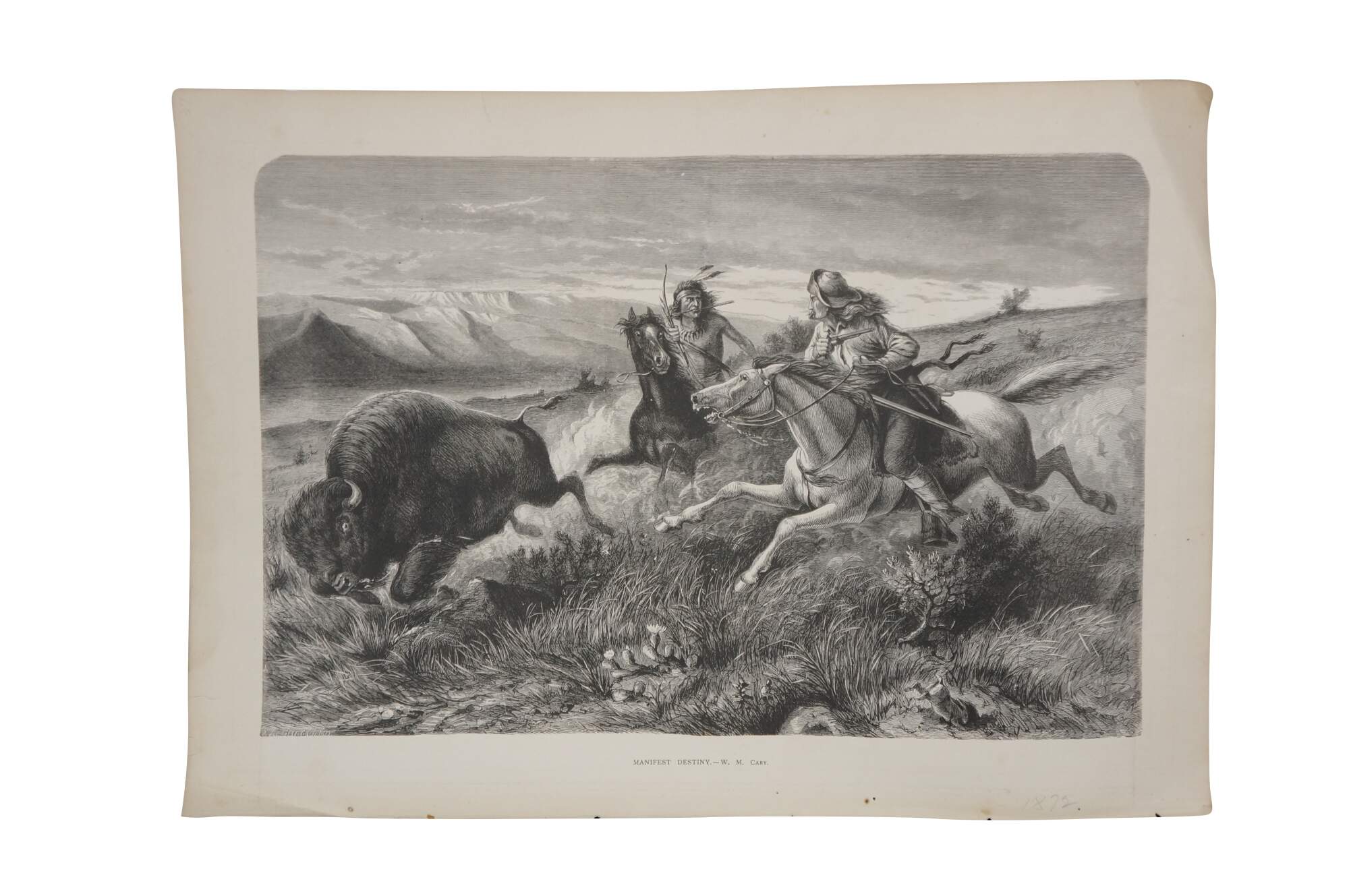
Shipping:
Free Shipping Included
Delivery:
Estimated 2-15 Business Days
Payments:
Credit Card, Check, Cash, PayPal, Apple Pay, Venmo
Returns:
30 Days 100% Money Back Guarantee, Buyer Pays Return Shipping
Description
Late 19th century black and white etching titled "Maifest Destiny" by William de la Montagne Cary, as published by Richard Brend'amour. Amrican Western landscape featuring a settler and Native American glaring at each other as they ride horseback hunting a bison. Signed in plate. Paper; unframed.
"William de la Montagne Cary (American 1840-1922) With a thirty-year career as a western illustrator based in New York City, William Cary made his first trip West in 1861 in an ox-wagon train along the Missouri River bound for Fort Benton where he narrowly escaped capture by the Crow Indians. From Fort Benton, he set out with a cook and guide and stayed at Fort Union for six weeks, where he observed life among the Assiniboine Indians nearby. He also signed on with a survey crew, which led him to the West Coast, and from there he took a ship back to New York City, In 1874, he took his second and last trip West, joining the John Mullan railroad survey to travel to Walla Walla, Washington. Most of his illustrations were based on a combination of memory and sketches from these trips. He had a widespread reputation for his illustration skills, which earned him numerous commissions from magazines including Leslie's and Harper's. He also did oil paintings, many of them of Indian women with his texts of verbiage that described the hard circumstances of these people, a reflection of the common Euro-American view of Indian life. Cary also did several paintings and an etching featuring Buffalo Bill Cody, a figure of the West that he first met in the 1860s. In 1884, Cary spent several weeks studying Cody's Wild West Show." (Source: Kodner Gallery)
"Franz Robert Richard Brend’amour (16 October 1831, Aachen – 22 January 1915, Düsseldorf) was a German wood-engraver, printer and publisher. He came from a Huguenot family; the first son of Johann Nikolaus Brend’amour, a police inspector, and his wife, Maria Sophia née Leruth. From 1846 to 1849 he was apprenticed to a wood-engraver named Eustach Stephan, in Cologne. When Stephan moved to Paris in 1850, he continued his training with Johann Anton Ramboux, a lithographer. He also translated classic woodcuts from the Renaissance. In 1856, he went to Düsseldorf, where he established the Xylographische Kunstanstalt Brend’amour & Cie, an "art institute", with several assistants. His business grew steadily so, in 1866, he brought in his brother-in-law, Rudolf Goldenberg, to handle its financial management. His illustrations for literary works brought him widespread recognition outside of Germany. He also provided them for magazines and newspapers, including the Illustrirte Zeitung, Über Land und Meer, and Die Gartenlaube. Presumably, not all of them were by Brend'amour himself; there were far too many. In 1872, at the International Polytechnic Exhibition in Moscow, the gold medal was officially awarded to his company, not Brend'amour personally. During the 1870s, he added branches in Berlin, Leipzig, Braunschweig, Stuttgart and Munich. He had business relations with companies in England, France and Spain. Gustav Kruell, who would later become a well known engraver in the United States, was an apprentice at the company's original branch in the early part of the decade. In 1898 his nephew, Fritz Goldenberg, and Heinrich Simhart established the graphic arts firm, Brend’amour, Simhart & Co, in Munich. From 1859 until his death, he was a member of the progressive artists' association, Malkasten, and the Verein der Düsseldorfer Künstler. In 1904, he was awarded the Prussian Order of the Crown. Five years later, he retired and received the Order of the Red Eagle. His workshop helped develop and disseminate several techniques, such as halftone and chemograms. A street is named after him in Oberkassel." (Wikipedia)
Condition
Good Overall - Gentle wear; slight discoloration, creasing to mat
Dimensions
16" x 11.5" (Width x Height)